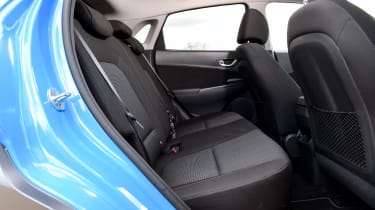Hyundai Kona (2018-2023) review - Practicality, comfort and boot space
Hyundai has improved the Kona's ride quality, but it's not the most practical small SUV

The level of practicality in the Kona illustrates just how quickly the small SUV market is developing. When Hyundai started work on its small SUV, it presumably benchmarked cars like the Nissan Juke and Renault Captur for passenger space and boot capacity.
Compared with those cars, the Kona doesn't do badly. But the game has moved on since the Kona landed, because it feels less capable of dealing with family life than, say, the Citroen C3 Aircross or MG ZS.
For instance, we found during our testing that there's the plenty of space in the cabin for the driver and front passengers, but those in the back seats may complain about a shortage of leg and knee room on longer journeys. Many buyers won't be put off by this relative shortage of versatility, of course – however, to us the Kona doesn't quite feel like a vehicle that could cope with the lifestyle of a small family.
Size
The Hyundai Kona measures 4,205mm long, 1,800mm wide (2,070mm including mirrors) and up to 1,568mm high, depending on which wheel size you opt for. By comparison, the Vauxhall Mokka is slightly shorter at 4,151mm and narrower at 1,791mm.
Leg room, head room & passenger space
The Kona is a nominal five-seater, of course, but it's still fundamentally a supermini-sized cabin - and you should factor that in if you regularly need to carry four adults. There's plenty of space up front for six-footers, and they shouldn't have any problems with headroom either. But if there's a pair of six-footers up front, the rear cabin looks a little bit tight for knee and legroom.
Boot
The standard mild-hybrid and full hybrid Hyundai Kona both feature a 374-litre boot, while the all-electric model has a reduced 332-litre load space, which is barely any more than a lot modern superminis. For example, a Volkswagen Golf for example has a 381-litre boot. Fold the Kona's rear seats down and you get 1,156 litres, which to us is no better than respectable. There's no clever boot tricks like a variable-height floor or dividers, either.
Towing
If you're looking for a Kona model to use for everyday towing duties, then you'll be better off with either the mild-hybrid or full-hybrid models which have maximum towing capacities of 1,200kg and 1,300kg respectively. The 276bhp Kona N performance model is able to pull up to 1,600kg.






